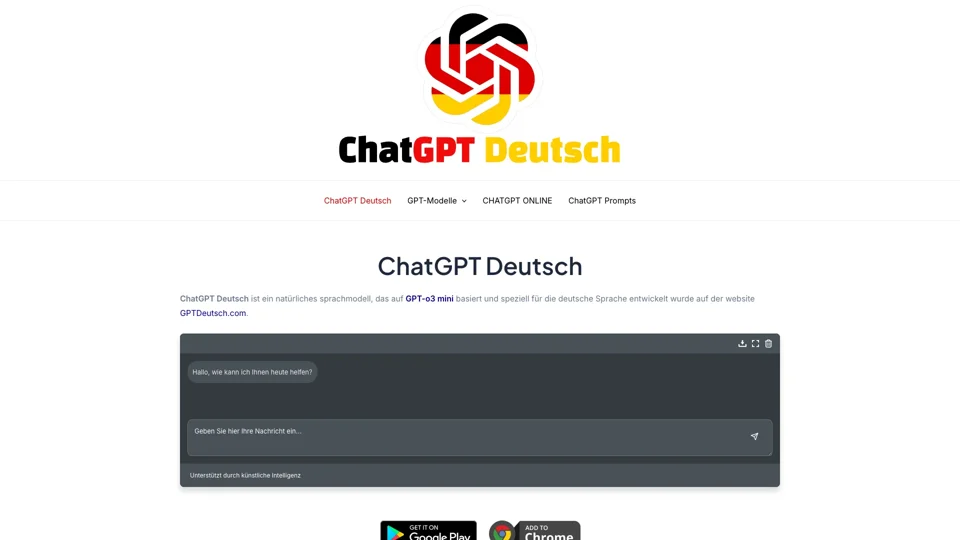ChatGPT Deutsch Overview
ChatGPT Deutsch is a natural language model specifically designed for the German language, based on the GPT-o3 mini model. It is available on the website GPTDeutsch.com.
Key Features
- High competence in understanding and generating German text
- Optimized for professional use cases requiring high-quality German language understanding
- Can be used for chatbots, text generation, and customer service
- Offers a high level of natural communication and nuance
GPT Models Comparison
The GPT series has undergone significant development, with each version introducing improvements in performance, efficiency, and answer quality. The table below compares the main features, performance, and application areas of GPT-3, GPT-3.5, GPT-3.5 Turbo, GPT-4, GPT-4o, and GPT-4o Mini.
| Feature | GPT-3 | GPT-3.5 | GPT-3.5 Turbo | GPT-4 | GPT-4o | GPT-4o Mini | | --- | --- | --- | --- | --- | --- | --- | | Release Date | June 2021 | March 2022 | November 2022 | March 2023 | June 2024 | July 2024 | | Parameters | 175 billion | Similar to GPT-3 | Optimized version of GPT-3.5 | Estimated 175-200 billion | Extended parameters | Optimized for smaller capacity | | Model Size | Large | Large | Medium | Very large | Large | Smaller | | Performance | High, but limited in context | Improved context understanding | Efficient and cost-effective | Superior understanding and nuance | Optimized for specific tasks | High efficiency and speed | | Answer Quality | Good for general inquiries | Better contextual answers | Fast and reliable | Excellent coherence and relevance | Balanced for specialized tasks | Fast and efficient | | Context Processing | Moderate | Improved processing compared to GPT-3 | Better than GPT-3.5 | Excellent, long-term context | High, tailored for specific uses | Good, suitable for high throughput | | Application | General conversations and tasks | Precise and nuanced tasks | Versatile, cost-effective | Complex and nuanced interactions | Specialized for demanding tasks | Fast, efficient | | Availability | Widely available | Widely available | Widely available | Available through API and subscription | Available through API and subscription | Available through API and subscription | | Training Data | Diverse internet sources | Extended and refined data compared to GPT-3 | Similar data sources with optimizations | Comprehensive and up-to-date data | Specialized datasets | Optimized for fast answers | | Cost | Generally higher per use | Generally higher per use | Cost-effective compared to GPT-3.5 | Higher due to advanced capabilities | Cost-effective for specific uses | Cost-effective and efficient | | API Access | Available through OpenAI's API | Available through OpenAI's API | Available through OpenAI's API | Available through OpenAI's API | Available through OpenAI's API | Available through OpenAI's API | | Special Features | Basic conversation and text generation | Improved dialog and understanding | Optimized for speed and cost | Advanced thinking and understanding | Tailored for complex, high-grade requirements | Designed for fast applications |
GPT o1, o1-preview, o1-mini, and o3-mini Models
OpenAI has introduced new models, including GPT o1, o1-preview, o1-mini, and o3-mini, which offer improved performance and specialized features for specific tasks.
- GPT o1: A large language model (LLM) developed to tackle complex argumentation tasks, using the "Chain of Thought" method.
- GPT o1-preview: A large language model (LLM) designed to improve argumentation and problem-solving capabilities, with the ability to recognize and correct errors.
- GPT o1-mini: A cost-effective model optimized for tasks in the MINT fields (mathematics, informatics, natural sciences, and technology), offering near-par performance to the larger o1 model.
- GPT o3-mini: A compact and powerful language model optimized for MINT tasks, offering improved performance and reduced error rates compared to o1-mini.
